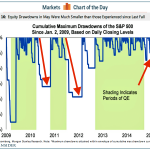The stock market seems to have gotten over its … – Business Insider

More Charts
In the post-financial-crisis era, a lot of stock-market watchers have attributed the market’s gains to the Federal Reserve’s ultra-easy monetary policy.And these folks had some evidence. They observed that whenever the Fed discontinued a quantitative-easing (QE) program, volatility would spike and stock prices would fall. QE involved the monthly purchases of billions of dollars worth of bonds, an effort that brought liquidity to all of the markets. Less liquidity typically means more volatility, so this made sense.
That narrative, however, has changed. Ever since the Fed ended its latest round of QE last October, volatility has remained low, and stock prices have continued to drift higher.
Morgan Stanley’s Adam Parker illustrated this in a chart of S&P 500 cumulative max drawdowns, which are amounts the market falls from a high to a low.
“Since the Fed completed tapering of QE3/4 last fall, there have been drawdowns of -7.4%, -4.95%, – 4.68%, and -3.64%, Parker said. “Individually, these drawdowns are not particularly large relative to those in the QE3/4 period, but their proximity is closer than similar magnitude drawdowns during that period. Compared with drawdowns in prior non-QE periods, however, the recent ones are much more modest.”
So is this a paradigm shift? Or was the relationship between QE and market volatility never really that strong?
“We continue to monitor market drawdowns for signs that the market misses the stabilizing presence of QE,” Parker said.
Morgan Stanley
NOW WATCH: Paul Krugman Explains Why There Are Two Kinds Of Economists And One Kind Is Wrong
Please enable Javascript to watch this video
Link:
The stock market seems to have gotten over its … – Business Insider

